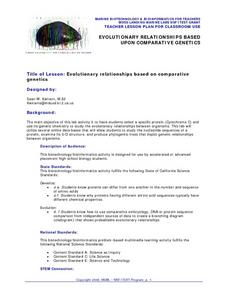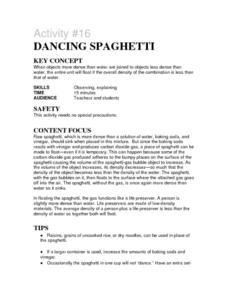Curated OER
I Wood if I Could
Tenth graders investigate the process of how specific products are made from trees. For this chemistry instructional activity, groups of students must choose among ice cream, bubble gum, paper, toothpaste and lipstick. They research,...
Curated OER
Build Your Own Atom
Students build a model of an atom using an online program. In this chemistry lesson, students discuss the different parts of the atom. They complete an independent research about their chosen element.
Curated OER
Playing With Polymers
Students explore the world of polymers. In this chemistry lesson, students make polymers and observe their properties. Follow-up questions and extension activities are included.
Curated OER
Mixing Oil and Water
Students explore physical science by participating in a class experiment. In this chemistry lesson, students discuss what they predict will happen when cooking oil and water are blended together. Students utilize a plastic bottle, food...
Curated OER
Chemical and Physical Changes
Eighth graders investigate different gas behaviors. In this chemistry lesson, 8th graders describe how changing volume and temperature affect gas particles motion. They collect data and make a generalization about these variables'...
Curated OER
An Alien Periodic Table
Students construct a periodic table based on the physical and chemical properties of elements. In this chemistry lesson, students share their work with the class and explain why they classified the elements that way.
Curated OER
Acidity
Sixth graders describe the physical and chemical properties of acids. In this chemistry lesson, 6th graders test the acidity of different solutions. They identify acids and bases using the pH scale.
Curated OER
Carbon: Structure Matters
Students explore the molecular structure of matter and how it can affect the physical characteristics of a specific material. They investigate the role carbon plays in the chemistry of life.
Curated OER
Physical and Chemical Changes
In this changes worksheet, students observe and record changes that occur in their every day life and classify these changes as either physical or chemical change. Students record their information in a graphic organizer.
Virginia Department of Education
Moles Lab Activities
Want my name and number? It's 6.0221415 times 10 to the 23rd, and my name is Avogadro. Providing nine different activities, experiments, and labs, this lesson keeps Avogadro relevant to your class all year long.
Curated OER
Investigating the Effect of Salinity on the Density and Stability of Water
Water with varying amounts of dissolved salt are dyed and then used to compare densities. The objective is to discover the effect of salinity, and therefore density, on ocean water on the stability of the ocean. Many branches of science...
Curated OER
Carbon Atom Mobile
Students research the element of carbon, its composition, and the importance of carbon to life on earth. Then they design model mobiles of carbon atoms to demonstrate their understanding of the configuration of protons, neutrons, and...
University of Colorado
Patterns and Fingerprints
Human fingerprint patterns are the result of layers of skin growing at different paces, thus causing the layers to pull on each other forming ridges. Here, groups of learners see how patterns and fingerprints assist scientists in a...
Teach Engineering
Basically Acids
Base your lesson plan on acids and bases on an informative resource. The first installment of a five-part module on the science behind Harry Potter has individuals investigate acid/base chemistry with the use of invisible inks. They also...
Curated OER
Evolutionary Relationships Based Upon Comparative Genetics
Students investigate the protein cytochrome c in an attempt to use its genetic chemistry to study possible evolutionary relationships between organisms. The lesson integrates technology with the use computers to perform DNA analysis.
Curated OER
Strange Bugs
As individuals or in small groups, marine biologists research and discuss archaea and their unusual behavior as compared to bacteria. Teach them about the chemical makeup of the cell membrane of these strange organisms. This complex...
Curated OER
Investigating Properties of Water: Temperature
Investigate how temperature affects the density of water and stratification that occurs in bodies of water when temperatures vary. Water of differing temperatures is given different colors to see the layers that form. The lesson plan is...
Curated OER
Let's Make a Tubeworm!
Students discuss deep-sea chemosynthetic communities then create a poster of a three-dimensional tubeworm. In this creative lesson students create their own tubeworm and write a written report on it.
Curated OER
Activity #16 Dancing Spagehetti
Learners experiment with floating the spaghetti, the gas functions like a life preserver. Pupils comprehend that a person is slightly more dense than water. They comprehend that a life preservers are made of low-density materials. The...
Curated OER
Water
Students conduct a series of investigations on the unique properties of water. In this general science lesson, students explain what causes water's surface tension. They explain the different stages in the water cycle.
Curated OER
Rain Forests: Sustainable Use
Students discuss their opinion on a teacher given scenario. In this chemistry lesson, students research the value of rainforests. They relate these ideas to current forestry practices.
Curated OER
Whose Life Is It?
Students consider the implications of cloning. In this science and ethics instructional activity, students consider when cases of cloning are ethical and when they are not as they discuss scenarios and their discussion questions.
Curated OER
Survival Science: How Evaporation and Condensation Can Save Your Life!
Eighth graders demonstrate how scientific principles can be used to provide resources in an emergency situation. In this evaporation lesson students view a demonstration on a solar still and see a brief PowerPoint presentation.
Curated OER
Life in a Drop of Water
Young scholars observe the wealth of living organisms in a drop of water from our freshwater ecosystems. They classify the types of organisms observed as single-celled or multi-cellular and use a key or chart to identify and name the...

























